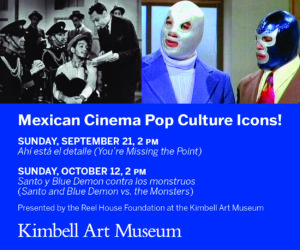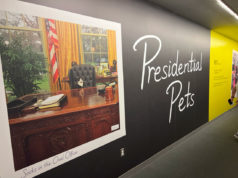So Fall Gallery Night happened last Saturday. Masses of people packed Fort Worth’s multiple galleries and impromptu art spaces, sipping on boxed wine, noshing on cheese cubes, and, of course, admiring the art on display. There certainly have been busier Fall Gallery Nights, but last Saturday’s was nothing to turn your nose up at. “Masses” translates to “hundreds.”
Birthed by the Fort Worth Art Dealers Association some 35 years ago –– and recently augmented by glomming-on ragtag art collectives and pranksters –– Fall Gallery Night is always a good barometer of the civic mood. Back before the economic meltdown of 2008, Fall Gallery Night had reached monstrous proportions, with seemingly every nook and cranny of the West Side’s available real estate (Fall and Spring Gallery Nights are West-centric) packed with art, booze, cheese, and people. The past couple of years have seen much fewer spaces but no less rowdy nights. The reduction in sites could be a result of the economy or the success of Fort Worth South Inc.’s newish biannual arts-related events. Arts Goggles are like Gallery Nights, but instead of just art, there’s a heavy dose of live music, food trucks, and bar-hopping.
Either way, the arts are a vital part of Fort Worth. And will always be, no matter what city council says or does.
Next week, when Fort Worth City Council members vote on a $1.4 billion budget, they will consider a staff recommendation to slash nearly $267,000 from funding for the Arts Council of Fort Worth and Tarrant County, a nearly 50-year-old nonprofit agency that distributes money to more than 40 local arts groups, including the Modern Art Museum of Fort Worth, Fort Worth Opera, and Texas Ballet Theater. The proposed 25-percent cut represents the latest in a string of cuts over the past five years, which have reduced the arts council’s overall funding by nearly 50 percent. The proposed 2013 cut would leave the arts council with about $800,000 to dole out.
[pullquote_right]The proposed 25-percent cut represents the latest in a string of cuts over the past five years, which have reduced the arts council’s overall funding by nearly 50 percent.[/pullquote_right]Arts supporters have been arguing that the arts council’s funding can be maintained by dipping into a $10 million surplus in the Culture and Tourism Fund, a reserve fueled by hotel taxes. Arts fans also claim that slashing arts funding is bad economics.
The arts are big business here. Tarrant County arts groups generated about $84 million in economic activity in 2010, according to a study released in June by the advocacy agency Americans for the Arts. But only 40 of the 99 eligible arts groups identified by the arts council participated in the study. Noticeably absent were heavy hitters like the Amon Carter Museum of American Art, Bass Performance Hall, and Kimbell Art Museum. Clearly, the arts are much more valuable to Fort Worth even than that $84 million suggests.
The belief that that $84 mil is just the tip of the iceberg is borne out by the national numbers. Metropolitan areas with much smaller populations than Tarrant County, including Jefferson County (greater Birmingham, Ala.) and Indianapolis, somehow managed to generate three to five times as much economic activity as Tarrant County.
Tarrant County arts manage to attract a decent amount of tourism. Nearly 30 percent of attendees, according to the study, are not from here, and most stay overnight — presumably in hotels, whose taxes feed the Culture and Tourism Fund.
The fund is used for the Fort Worth Convention Center and the Will Rogers Memorial Center.
Which brings up some food for thought.
Not only do most cities use similar funds to support the arts –– hence the inclusion of “culture” in the title –– but Ed Bass is dead set on building a new equestrian arena, mainly for the annual Fort Worth Stock Show and Rodeo. The new arena will be located near the Cultural District site of the existing arena, the architecturally significant but badly outdated Will Rogers Coliseum (built in 1936). But no one outside of Bass and his minions knows anything about the proposed project, including its funding source. (In May 2011, Bass, via Fort Worth State Rep. Charlie Geren, tried to get his hands on some taxpayer money by changing state law to allow one certain, unnamed city –– that could have been only Fort Worth –– to raise its hotel tax from the state limit of 15 percent to 18 percent. The plan was scrapped after the Hotel Association of Tarrant County raised holy hell.)
In a long letter sent a few days ago to the city council, Douglas Harman, former head of the Fort Worth Convention & Visitors Bureau, lays out a series of concerns, especially about the prospective new arena in relation to the Culture and Tourism Fund.
“The planned new arena appears to fit into [city council members’] budget decisions,” he writes, noting that a Cultural District street, Harley, is being relocated in anticipation of breaking ground on the new arena on nearby Montgomery Street. “Although city council members claim that they have not seen the plans for the new arena, the city council is spending millions of dollars to prepare the area for the new arena through the Harley relocation and stormwater work. It is difficult to believe that city council would spend millions of dollars relocating Harley and doing all of this site improvement work without full knowledge about the planned arena. So much for transparency of government decision making!”
Remember, Harman is a former city manager and chamber of commerce guy — not a bomb-thrower.
There’s nothing wrong with a new arena for cowboys, and there’s nothing wrong with cowboys in general, of course. But everyone knows that cowboy culture is not going to attract and keep a well educated, prosperous, imaginative workforce.
The arts will.
Based on the study, Fort Worthians are just crazy about the arts. Yes, visitors are important, but chances are that when a Fort Worthian goes to an arts show in town, he or she will be among fellow Fort Worthians. Nearly 76 percent of every audience at every nonprofit cultural event in Tarrant County is composed of Tarrant County residents, a percentage that ranks above average nationally and is third-highest of the nine Texas regions represented in the study.
Once again, no matter what city council says or does, the arts are here to stay –– because we are.












